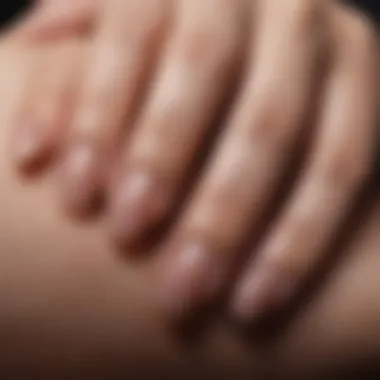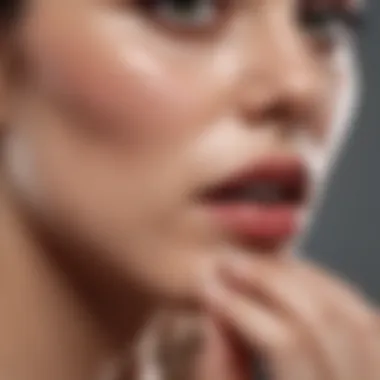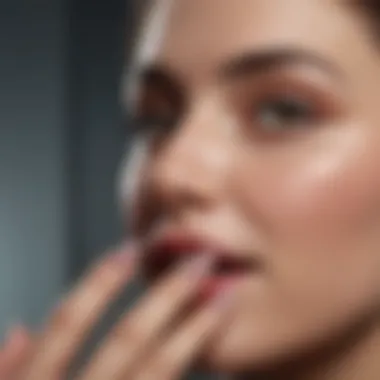Understanding the Multifaceted Causes of Hangnails


Intro
Hangnails, though often overlooked, are an insidious annoyance that many people encounter. These small, jagged skin flaps near the nail bed can become painful or even lead to infections if not addressed properly. When we discuss hangnails, it is crucial to delve into what causes them—this understanding can significantly improve nail care practices and outcomes.
This article aims to illuminate the multifaceted factors that lead to hangnail development, encompassing biological, environmental, and habitual influences. We will explore how our bodies, surroundings, and personal behaviors play critical roles in the health of our nails. As we uncover these aspects, readers will gain an exceptional insight into effective nail care strategies that can help mitigate hangnail occurrences and enhance overall nail health.
Insider Beauty Tips
Understanding how to care for your nails and the surrounding skin is essentialsurd for preventing hangnails. Here are some key tips that can aid in maintaining nail integrity:
- Moisturize Regularly: Keeping your nails and cuticles hydrated can prevent the skin from drying out and forming hangnails. Utilize a nourishing hand cream or cuticle oil daily.
- Limit Moisture Exposure: While hydrated skin is essential, excessive exposure to water can weaken the skin and cause it to tear. Consider wearing waterproof gloves when washing dishes or cleaning.
- Proper Nail Trimming: Regular triming of nails helps maintain their health, be careful not to cut too close to the cuticle as that can provoke hangnail formation.
“Insisting on a precise nail care routine can help avoid most issues related to nail health, including hangnails.”
Skincare Tips
Supplemental skincare routines can be beneficial. Here are some recommendations:
- Use cuticle creams that have natural oils to nourish the skin around the nails.
- Include biotin in your diet. This vitamin can strengthen brittle nails.
- Pay attention to changes in your body and consult a healthcare professional if you notice recurring hangnails.
Beauty Hacks
In addition to nurturing the skin, there are also practical tips known to minimize hangnails:
- Before bed, apply a generous amount of moisturizer nad wear cotton gloves overnight to lock in the hydration.
- If you notice an incoming hangnail, immediately nip it off with clean manicure scissors. Addressing it quickly can stave off further irritation.
Prevention and Care
Outside of tips, it’s also vital to understand more about maintaining nail health over time. Keeping stress levels in check and ensuring a balanced diet rich in essential vitamins can to an extent keep hangnails at bay. Staying informed about nail products and investing in quality items will play a significant role in targeting specific nail issues more effectively.
Overall, care practices and personal habits define much about nail health. By adhering to these simplestrategies, one can foster healthier nails while minimizing the occurrences of hangnails.
Prologue to Hangnails
Hangnails are often dismissed as a minor inconvenience, yet they offer valuable insights into overall nail and skin health. When understanding hangnails, one digs deeper into their origins, insights embodied in anatomical, biological, environmental, and habitual contexts. This article ventures into these dimensions to leave no stone unturned.
What are Hangnails?
Hangnails refer to small strips of torn skin that develop near the nail bed, off concerning the cuticle area. While they are typically benign, their presence can indicate underlying issues regarding nail health or excessive skin dryness. Anyone who has had a hangnail knows they can be painful. Unfortunately, if not treated or managed correctly, they may lead to infection or inflammation.
Different conditions precipitate the emergence of hangnails. Correctly identifying these causes provides essential guidance for prevention strategies. While their occurrence can appear random from a distance, distinct factors and mechanisms contribute continuously to their formation.
Significance of Nail Health
Nail health extends beyond mere aesthetics; it serves as a crucial indicator of our personal care habits and general well-being. Healthy nails denote a strong physiological state, while unhealthy nails may serve as a red flag.
Key aspects emphasize this significance:
- Protection: Nails protect fingers and toes from microorganisms and physical damage.
- Indicator of Health: Changes in nail appearance, such as shape or color, can herald systemic medical conditions.
- Confidence: Well-maintained nails contribute to personal and social acceptance, impacting self-esteem notably.
The connection between skin care and nail health becomes clearer when compounded by factors contributing to hangnails and poor nail care practices. By emphasizing thorough nail health in conjunction with versed techniques, individual care regimens can improve drastically, enabling one to circumvent the bothersome facets of hangnails altogether.
Anatomy of the Nail
The anatomy of the nail is crucial when discussing hangnails. It provides insight into the structure and function of nails as well as the surrounding skin. Understanding these elements can help one recognize how hangnails form and what might contribute to their occurrence. Moreover, awareness of nail anatomy can inform care routines, reducing the likelihood of hangnails developing in the first place. Incorporating this knowledge is essential in promoting overall nail health, as complications can arise from inadequacies in nail care.


Structure of Fingernails
Fingernails are more than just a hard surface at the tips of our fingers; they are complex structures that serve important functions. Each nail consists primarily of a protein called keratin, which lends durability and strength. The visible part of the nail is known as the nail plate, and beneath it lies the nail bed, comprising living tissue that provides support and nourishment.
At the base of the nail, the lunula, a crescent-shaped area, can often be seen. This is where nail growth begins. Understanding the growth cycle is vital because hangnails often form when health issues interfere with growth. Here are key components of the fingernail structure:
- Nail Plate: The hard surface we see, serving as protection for the sensitive underlying tissues.
- Nail Bed: Contains blood vessels and nerves that are crucial for sending nutrients.
- Lunula: The visible part of the nail matrix, seen at the base of the nail.
Role of Cuticles
Cuticles play an essential role in nail health and integrity. This thin layer of skin at the base provides a barrier, protecting the nail matrix from bacteria and viruses. When cuticles become dry or damaged, they can become a factor in developing hangnails. They may risk splitting, which can subsequently lead to hangnail formation.
It is important to maintain the cuticles properly to prevent potential damage. Proper cuticle care involves hydration and gentle pushing rather than cutting. Following a few simple practices helps:
- Using oil or cream daily can help keep cuticles moisturized.
- Avoiding harsh chemicals is crucial to protect this delicate skin.
Neglecting your cuticles may contribute to issues such as hangnails and infections.
Understanding the anatomy of the nail substantiates the relationship between structural components and hangnail formation. Awareness grants readers insights they need for effective nail care which in turn fosters better health and appearance.
Biological Factors Contributing to Hangnails
Understanding the biological factors contributing to hangnails is vital for navigating the complexities of nail care. Biological predispositions, which encompass genetic, age-related, and hormonal elements, significantly impact the health of nails and surrounding skin.
Genetic Predisposition
Genetics play a role in the likelihood of developing hangnails. If family members often experience this issue, there may be inherited traits affecting skin structure and vulnerability. Certain genetic factors influence skin quality and nail growth. For instance, a condition called onychoschizia results in brittle nails, making them more prone to issues like hangnails. Genetic predispositions can determine overall susceptibility to skin conditions that exacerbate hangnails.
Key Insights:
- Inherited skin quality.
- Family history impact.
- Beauty routine adaptation based on genetic traits.
Age-related Skin Changes
Aging impacts cell turnover and moisture retention in skin, which in turn affects nail and cuticle health. As individuals age, the production of natural oils decreases, leading to dry and flaky skin around the nails. This dryness can encourage the formation of hangnails. Furthermore, older adults might experience slower healing processes when injuries occur. Overall, age is a factor that necessitates a more conscientious approach to nail care as one grows older.
Important Considerations:
- Moisturizing becomes crucial with age.
- Regular nail trimming to prevent damage.
- Avoiding the temptation to pick at skin.
Hormonal Influences
Hormones play a significant role in various bodily functions, and nail health is no exception. Changes during pregnancy, menstrual cycles, or menopause can alter skin hydration and elasticity. Fluctuating hormone levels may result in increased sensitivity of surrounding skin, making hangnails more likely. For instance, during pregnancy, women may find their nails grow faster, yet the increased swelling can lead to an uptick in hangnail development. Hence, understanding these hormonal fluctuations is essential when exploring the underlying reasons for hangnails.
Additional Observations:
- Importance of tracking hormonal cycles.
- Adapting self-care routines during hormonal changes.
- Consulting healthcare professionals for severe skin issues.
The interplay among genetics, aging, and hormonal factors underscores the need for specific approaches to effectively manage nail health.
The exploration of these biological factors provides a foundation for recognizing the nuances of nail care. By being informed about these aspects, individuals can take proactive steps to lessen potential hangnail formation. Nutritional factors, environmental aspects, and habitual causes are also critical to complete the understanding of hangnails.
Environmental Factors
Understanding the environmental influences provides crucial insights into the formation of hangnails. The external surroundings we exist in significantly impact our overall nail health. Various environmental elements can exacerbate the conditions that lead to hangnail development. By recognizing these factors, individuals can take proactive measures to protect their nails and skin from potential harm.


Climate Effects
Climate plays a vital role in nail and skin health. For instance, dry climates can lead to moisture loss and create brittle skin around the nails. This dryness is more pronounced during the winter months when indoor heating exacerbates the lack of humidity. On the other hand, humid climates may cause other issues by fostering fungal growth, potentially leading to skin irritation and hangnails.
To minimize the impact of climate, one should pay close attention to seasonal changes and adjust care routines accordingly. Incorporating a good moisturizer can make a difference in either dry or humid conditions.
Chemical Exposures
Chemicals are pervasive in day-to-day life. Exposure to harsh cleaning agents or chemicals used in manicures may strip essential moisture, leading to weaker skin integrity around the nails. Common substances, like acetone and alcohol, while effective for removing polish, can severely dry out the skin if used frequently.
Choosing milder products and reaching for non-toxic nail polishes can limit exposure to harsh chemicals. Look for labels indicating
Habitual Causes of Hangnails
Many factors impact nail health, but habitual behaviors are a key element to consider. When we speak about Habitual Causes of Hangnails, we focus on the repeated actions that contribute significantly to the development of hangnails. It is important because these habits can often be modified, which may lead to significant improvements. Understanding how certain actions can trigger this condition empowers individuals to make informed decisions on preventing associated issues.
Nail Biting
Nail biting is a widespread habit that can worsen nail and skin health. This behavior, often tied to stress or anxiety, not only harms the nails themselves but also the surrounding skin. The skin that is damaged as nails are bitten can result in increased vulnerability to hangnails. When the skin around the nail bed becomes loosened or torn, hangnails become more likely to form. Regular nail biting can lead to chronic issues, making it more crucial for individuals to seek strategies to prevent or eventually stop this behavior.
Picking at Skin
Picking at the skin near the nails significantly increases the risk of developing hangnails. This common compulsion is often influenced by anxiety or restlessness. When skin is picked, micro-tears can occur, which can lead to inflammation and ultimately the development of hangnails. Taking note of leads and urges to pick can heighten awareness and help create methods to break this habit. Keeping nails trimmed and smooth can often help reduce the physical temptation to rip at the surrounding area.
Inadequate Nail Care
Often, lethargy concerning basic nail care can contribute to hangnail development. Failing to moisturize both nails and cuticles can lead to dryness. Dry surrounding skin makes it less elastic, which may prompt tearing or the emergence of hangnails. A proper nail care regimen includes regular trimming, hydration of the nail bed and skin, and smooth-cut. This simple practice can lead to healthier nails over time and can diminish the anecdotes of hangnails. Consistency in applying creams or oils to the nails keeps both the skin and nails nourished, worsening exposure is significantly less likely.
A fundamental understanding that habits play a critical role can guide one toward proactive nail health. Examining these behaviors allows for better care and maintenance in a long-term journey toward healthy nails and skin.
Nutritional Factors
The connection between nutrition and the health of our nails is significant yet often overlooked. Nutritional factors play a crucial role in maintaining the integrity of the nails, as certain vitamins and hydration levels influence their strength and appearance. A well-balanced diet contributes to overall skin health, impacting areas surrounding the nails, which is essential in preventing hangnail formation.
Vitamin Deficiencies
Vitamins, particularly biotin, vitamin E, and the B complex vitamins, are essential in supporting nail health. Deficiencies in these nutrients can lead to brittle nails and cracked skin around the nail bed. Biotin is well-known for its ability to promote nail growth and strength. It is often recommended to individuals dealing with nail issues.
For instance, if there is an inadequate intake of vitamin E, the skin may become dry and vulnerable. This dryness can further lead to hangnails. Furthermore, B vitamins aid in cell regeneration, an important factor in maintaining healthy skin and cuticle area. An evolving understanding of these linkages enhances our approach towards nail care and prevention strategies.
Impact of Hydration
Hydration plays a fundamental role in keeping the skin around our nails supple and resilient. The body needs water to maintain moisture levels within cells. When thirst is neglected, skin can dry out, including the areas around the fingers, resulting in hangnail formation.
For optimal nail care, it is recommended to drink adequate amounts of water throughout the day. Supplemental hydration with hand creams that contain hydrating ingredients can be advantageous. It is also wise to check for hydrating serums or oils that contain natural components such as glycerin and hyaluronic acid, as they help retain moisture and lush vitality to the nails and surrounding skin.
Proper nutrition and adequate hydration are two corners for maintaining the health of nails and skin, aligning with effective hangnail prevention.
Implementing changes to ensure sufficient vitamin intake and hydration can create a notable difference in nail health. It aligns with the overall focus on nail care for beauty enthusiasts, makeup lovers, and skincare aficionados to ensure attention to the source level, promoting not just age but lasting beauty.
Preventive Measures
Preventive measures are critical when considering hangnails. Understanding how to effectively manage your nail and skin health can minimize their appearance and onset. Consistent attention to personal nail care can greatly enhance overall nail aesthetics, keeping them tidy and healthy. Developing these habits not only benefits nail appearance but also helps in avoiding potential pain.
Proper Nail Care Regimen


A proper nail care regimen involves various practices that benefit the nails over time.
- Regular Trimming: Keeping nails well-trimmed reduces the exploitatively of hangnails. Trimming should be done carefully, straight across, to avoid sharp edges.
- File Regularly: Use a soft file after trimming to smooth edges, reducing risks of snagging and potential pain.
- Choose Appropriate Tools: High-quality nail clippers and files prevent unnecessary trauma to nails and surrounding skin. Avoid using makeshift tools for nail care as they can cause more harm than good.
Practicing these steps helps create a solid foundation for strong nails.
Moisturization Techniques
Moisturization is crucial to maintaining supple skin around the nail beds. Here are some techniques:
- Apply Hand Cream: Using a good hand cream daily, especially after washing your hands, keeps the skin hydrated. Look for creams containing glycerin or sheabutter for improved effectiveness.
- Cuticle Oils: Utilizing cuticle oil strictly around the nails can enhance skin flexibility and prevent cracks from forming. Plant oils such as jojoba or argan oil can serve well because of their nourishing properties.
- Soak Treatments: Periodic soaking of hands can also improve moisture retention in nails and skin. Perhaps immersing hands in warm water with olive oil can offer restorative benefits.
Regular moisturization leads to lower risk of developing dry, jagged skin that often results in hangnails.
Dietary Recommendations
Your diet plays a direct role in your nail health. A few nutritional recommendations can enhance the strength of nails:
- Protein-Rich Foods: Diet carrying lean meats, eggs, and cells like legumes fosters keratin production, the building block of nails.
- Hydration: Ensuring adequate hydration is vital. Drink sufficient water throughout the day for complete bodily hydration which includes skin moisture.
- Vitamin Intake: Focus on B-vitamins and Biotin. Foods like bananas, nuts, eggs provide these minerals that are beneficial in sustaining paricularlyn nails in good health.
Evaluating dietary habits regularly can influence your susceptibility to hangnails effectively.
Emphasizing preventive measures not only reduces the occurrence of hangnails but also enhances overall hand health and confidence in presentation. Adjusting routines can lead to immediate and long-lasting improvements.
Treatment Options
The exploration of treatment options for hangnails is essential in this article. Hangnails, while often regarded as a minor nuisance, can lead to discomfort and infection if not addressed properly. Understanding the various approaches—ranging from self-care to professional help—is vital for effective management and prevention. Proper treatment not only alleviates immediate discomfort but also promotes healthier nails in the long term.
Self-Care Approaches
Self-care is the first line of defense against hangnails. Simple and practical methods can prevent many instances of hangnail growth. Below are some effective self-care strategies:
- Maintain Cuticle Integrity: Regular gently push back cuticles with a proper cuticle pusher after bathing or showering to avoid tears.
- Softening Treatments: Use cuticle oils or creams that contain moisturizing agents like jojoba oil and vitamin E. This keeps the cuticle and surrounding skin soft, reducing the risk of hangnails.
- Stay Hydrated: Consuming enough water throughout the day is essential. Adequate hydration promotes skin elasticity and minimizes dryness, which is a common trigger for hangnails.
- Trim with Care: Avoid ragged edges by trimming nails slightly and gently. Do not tug on the skin around the nail but instead, cut away any hanging pieces carefully with sanitized nail scissors.
- Avoid False Nails: If you frequently experience hangnails, consider eliminating artificial nails. They can put undue pressure on the nail bed and irritate surrounding skin.
Integrating these self-care practices into one’s daily routine can greatly decrease the chances of developing hangnails.
Professional Interventions
While self-care is vital, sometimes professional intervention is required. Factors such as severe hangnails or recurrent issues may necessitate seeking help from a dermatologist or a nail technician. Here are common professional options:
- Expert Assessment: A professional can evaluate the severity of the issue. Their expertise will provide insight into underlying causes such as skin conditions or infections.
- Medical Treatment: If the hangnails are infected or not responding to care, a dermatologist may prescribe antibiotics or topical treatments.
- Manicure Services: Regular visits to a skilled manicurist can support nail health. Professional manicures that include cuticle care may enhance the overall condition of nails and surrounding skin.
- Surgical Intervention: In extreme cases where persistent hangnails disrupt normal life, surgical options may be considered. This might involve removing problematic nail folds or excess skin.
Epilogue
In summarizing the causes and prevention of hangnails, it is essential to recapitulate the multifactorial nature of their development. This article highlights how various biological, environmental, and habitual influences interact to contribute to the onset of hangnails, offering insight into this common yet often overlooked issue.
Understanding different aspects of hangnail formation allows for effective management strategies. Knowledge of biological factors such as genetic predisposition and age-related skin changes gave significant insight into how individuals may be differently affected. Moreover, the role of environmental factors like climate and chemical exposures cannot be understated. These factors not only influence nail health but also introduce forms of damage that can lead to hangnail development.
Habitual causes related to personal grooming can also play a critical role. Unsurprisingly, nail-biting and improper cuticle care only serve to exacerbate the risk. Recognizing these habits opens pathways to degree improvement and prevention. By adopting simple measures such as a proper nail care regimen, individuals also stand a better chance of minimizing the risk of hangnails.
Summarizing Causes and Prevention
To prevent hangnails effectively, one must address the specific causes identified in this article:
- Biological Factors:
- Environmental Factors:
- Habitual Causes:
- Genetics: Understanding one's own genetic predisposition can lead to tailored preventive strategies.
- Age-Related Changes: Adapting care as skin ages seems practical.
- Climate: Dry conditions may warrant the use of more moisturizer.
- Chemicals: Reducing exposure to harsh soaps can preserve nail health.
- Behavior Change: Identifying and altering habits like nail-biting can be significant.
- Regular Maintenance: Establishing a sound nail and cuticle care routine ensures even the thin skin surrounding the nails doesn't suffer.
Ultimately, nurturing a vested interest in nail care leads to broader health benefits. Acknowledging these causes paired with effective preventative steps equips one with the tools to keep hangnails at bay, resulting in healthier, more resilient nails. For those passionate about nail health, this comprehensive overview aims to promote ongoing awareness and care that enhances both beauty and well-being.







